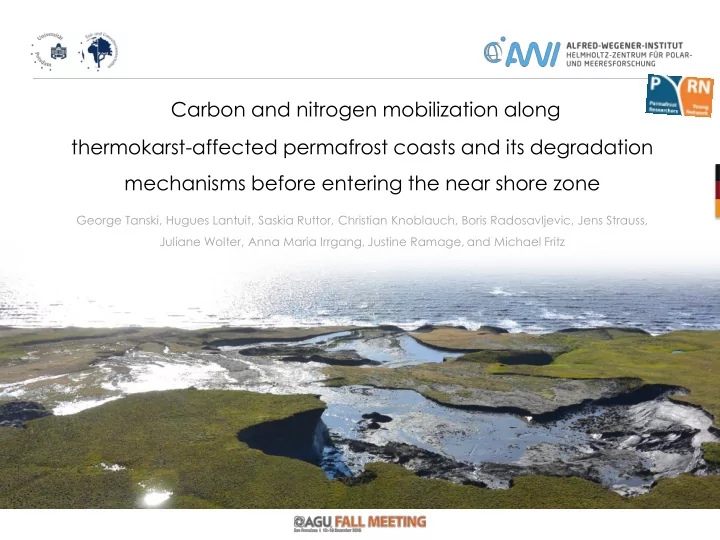

Carbon and nitrogen mobilization along thermokarst-affected permafrost coasts and its degradation mechanisms before entering the near shore zone a George Tanski, Hugues Lantuit, Saskia Ruttor, Christian Knoblauch, Boris Radosavljevic, Jens Strauss, Juliane Wolter, Anna Maria Irrgang, Justine Ramage, and Michael Fritz
I. Introduction II. Study area III. Methods IV. Results V. Discussion VI. Conclusion 34 % of global coasts 400,000 km coastline 1/3 unlithified cliffs 18 % ground ice 0.6 m yr -1 erosion Lantuit et al. 2012
I. Introduction II. Study area III. Methods IV. Results V. Discussion VI. Conclusion Gt C org. Global carbon storage in soils * Tarnocai et al. 2009 *SOC content in 0 – 3 m of soils: 1035 ±150 Pg ( Hugelius et al. 2014) 66 Pg nitrogen (N) in the uppermost 3 m ( Harden et al. 2012)
I. Introduction II. Study area III. Methods IV. Results V. Discussion VI. Conclusion Quantify and compare terrestrial OM contents • Assess transformation processes after affected by thermokarst • Track fate of terrestrial OM in the nearshore zone •
I. Introduction II. Study area III. Methods IV. Results V. Discussion VI. Conclusion Cont. permafrost ~600m depth Ground ice 37% Coastal erosion 0.7m yr -1
I. Introduction II. Study area III. Methods IV. Results V. Discussion VI. Conclusion
I. Introduction II. Study area III. Methods IV. Results V. Discussion VI. Conclusion
I. Introduction II. Study area III. Methods IV. Results V. Discussion VI. Conclusion
I. Introduction II. Study area III. Methods IV. Results V. Discussion VI. Conclusion Undisturbed (Active layer, Permafrost) Ice volumes TOC TN δ 13 C-TOC C/N Disturbed δ 13 C (Mudpool, Transition zone, Slump floor, Thaw stream) NH4-N DOC DN/DIN δ 13 C-DOC Bio- marker Nearshore (Marine sediments)
I. Introduction II. Study area III. Methods IV. Results V. Discussion VI. Conclusion
I. Introduction II. Study area III. Methods IV. Results V. Discussion VI. Conclusion Height Vol. DOC conc. I 0.4m 3% 65.9 mg L -1 II 2.5m 14% 66.8 mg L -1 III 14.0m 83% 2.9 mg L -1 13.9 mg L -1 26.5 mg L -1
I. Introduction II. Study area III. Methods IV. Results V. Discussion VI. Conclusion C/N
I. Introduction II. Study area III. Methods IV. Results V. Discussion VI. Conclusion NH4-N
I. Introduction II. Study area III. Methods IV. Results V. Discussion VI. Conclusion Bio- marker
I. Introduction II. Study area III. Methods IV. Results V. Discussion VI. Conclusion TN
I. Introduction II. Study area III. Methods IV. Results V. Discussion VI. Conclusion OM contents decrese substantially due to thermokarst formation before entering the nearshore zone Dilution, mineralzation, direct transport, and plant uptake as main transformation mechanisms OM directly buried in nearshore sediments, esp. heavier fractions OM characteristics are drastically changed due to theromkarst Thermokarst along ice-rich coasts with strong impact on the coastal environment
I. Introduction II. Study area III. Methods IV. Results V. Discussion VI. Conclusion What happens with permafrost carbon after transport into the ocean? What are possible impacts on marine ecosystem in the nearshore? How is OC incorporated into local food webs ?
Acknowledgement
Thank you very much for the attention! www.awi.de/forschung/nachwuchsgruppen/coper Arctic coastal erosion group
Recommend
More recommend